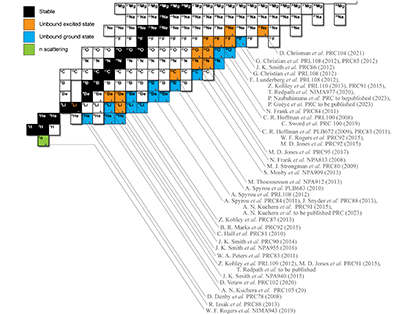
Professor of Physics
Joined the laboratory in 2018
Education and training
- MS, Physics, Université Cheikh Anta Diop, Senegal, 1990
- PhD, Physics, Université Clermont-Ferrand II, France, 1994
Research focus
- Experimental nuclear physics
Contact information
Research
The nucleus of the simplest atom (hydrogen) is composed of a single proton. How does nature go from hydrogen to heavier elements? What happens when many more nucleons are packed into a small place? Are any of these exotic nuclei better for imaging or therapy applications? These and many more questions are vital to our understanding of the universe and contribution to society. My research focuses on neutron-rich isotopes along the neutron dripline. I am a member of the MoNA Collaboration that studies these unique systems using the MoNA-LISA modular neutron detector and a large-gap superconducting sweeper magnet.

Biography
Paul Guèye received his BS and MS in Physics and Chemistry from the University Cheikh Anta Diop (Senegal). He obtained his PhD in Nuclear Physics from the University of Clermont-Ferrand II (France) on electron/positron scattering off carbon and lead. He was then a postdoc with the nuclear physics group of Hampton University on the first strange quark experiment at the Thomas Jefferson National Accelerator Facility (Virginia, USA). He joined the MoNA Collaboration in 2013 to study rare isotopes at the Facility for Rare Isotope Beams. He chaired the Hampton University Physics Department in 2015-2018 and joined Michigan State University in the fall of 2018. Scientific discoveries require a varied pool of people, each with their unique talents and abilities. His group is reflective of his passion to provide exciting multi-disciplinary opportunities for anyone interested in gaining some knowledge and contributing to basic and applied nuclear science fields.
How students can contribute as part of my research team
I am utilizing my expertise from high-energy electron scattering to enhance our existing research in various areas: the development of a highly segmented gas electron multiplier-based active target, a small-scale neutron detector complementing the MoNA-LISA arrays, a Cherenkov detector, a silicon-based and spherical GEM-based detectors for elastic scattering measurements, and a GEANT4 Monte Carlo simulation general framework for FRIB. I am also interested in enabling spin-dependent observables through polarized beams and targets for rare isotope research and investigating the possibility of a compact polarized electron/positron linac for lepton scattering experiments off rare isotopes. Students will have the opportunity to contribute to all aspects of the aforementioned projects.
Scientific publications
- Reduction of Spectroscopic Overlap Across the Z = 8 Shell in Neutron-Rich Nuclei, T. Redpath, P. Guèye et al., Phys. Rev. C109, 054325 (2024).
- Dispersive Corrections to the Born Approximation in Elastic Electron-Nucleus Scattering in the Intermediate Energy Regime, P. Guèye et al., Eur. Phys. Jour. A56:126 (2020).

